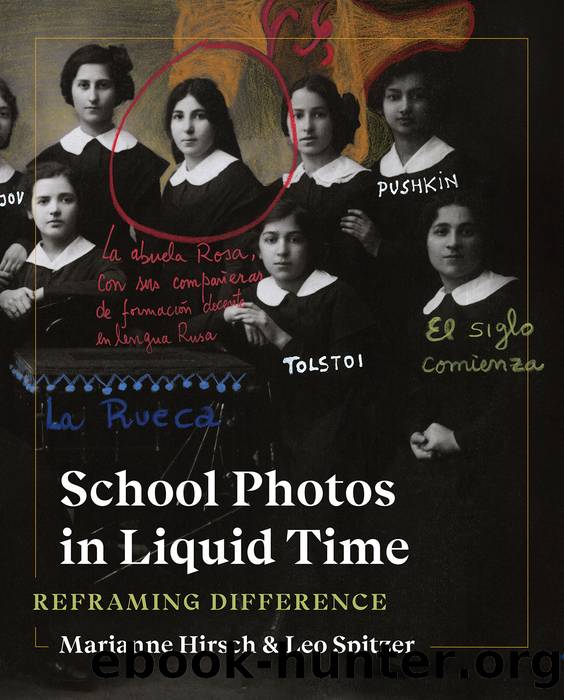School Photos in Liquid Time by Marianne Hirsch;Leo Spitzer;

Author:Marianne Hirsch;Leo Spitzer;
Language: eng
Format: epub
ISBN: 9780295746555
Publisher: University of Washington Press
Published: 2019-10-14T16:00:00+00:00
FIGURE 2.23. Adrian Piper, Decide Who You Are #15: You Donât Want Me Here, 1992. Three silkscreened image-text collages printed on paper and mounted on foam. See also plate 5. (Private Collection. © Adrian Piper Research Archive Foundation Berlin.)
Describing the work, on the right, we see one of Adrian Piperâs iconic images of a smiling little black girl, with hair pulled back, standing at the very bottom of the large rectangular frame. Printed above and over her is a long text in red composed of short phrases in a direct address by an âIâ to a âyou:â âItâs fine. I donât know why you say that. Iâm amazed that you see things that way. It wasnât intentional. Just calm down. Isnât this a little bit much? Youâre making too much of this.â On the left, there is a drawing on grid paper of three monkeys holding their hands over their eyes, ears and mouth, respectively. The text, in red on the blue grid above them, is, again, a direct address, containing phrases like: âyou donât want me here; you think I donât know it.â
In our interpretation, this picture of the socially isolated and unwanted child at the center of this work, rather than one of the more conventional images of groups of younger children in mixed classrooms from this moment of integration, creates a scathingly critical school photo, questioning even the possibility of integrated schooling in the face of entrenched racial hatred. The three panels together powerfully stage the hostile exchange we witness in the 1957 photo of Elizabeth Eckford. As we read them aloud and actually hear them, the phrases on the right panel are phrases that white people whisper or shout at black children, silencing and intimidating themâphrases Elizabeth Eckford no doubt heard all her life. Negating the childâs feelings and responses, the voice overwhelms her with a logic of denial and erasure. The three monkeys on the left, holding their hands over their eyes, ears, and mouth, perform a version of âsee no evil, hear no evil, speak no evil.â In a reversal of violent stereotypes, whites are represented as apes while a black voice tries to break through their hostility, demanding to be heard. We can imagine that this is the voice of the silent Elizabeth Eckford, whose presence at the white high school is so unwanted.
As we see them, the three separate, unconnected rectangular panels perform the isolation of the black child under segregation. The two voices speak or shout across the figure of the student who is being denied entrance to school. They do not hear each other. But they enable us to listen to the 1957 photograph itself, to hear the ugly commotion in front of that school. The two black childrenâthe little girl on the right and the older high school student in the centerâare edged out of the picturesâ frames. Piperâs triptych enlarges the frame of the archival image and places it into liquid timeâthe longue durée of racist exclusion that produced this scene, a scene that reverberates across time and space.
Download
This site does not store any files on its server. We only index and link to content provided by other sites. Please contact the content providers to delete copyright contents if any and email us, we'll remove relevant links or contents immediately.
Shoot Sexy by Ryan Armbrust(17142)
Portrait Mastery in Black & White: Learn the Signature Style of a Legendary Photographer by Tim Kelly(16484)
Adobe Camera Raw For Digital Photographers Only by Rob Sheppard(16388)
Photographically Speaking: A Deeper Look at Creating Stronger Images (Eva Spring's Library) by David duChemin(16161)
Bombshells: Glamour Girls of a Lifetime by Sullivan Steve(13109)
Art Nude Photography Explained: How to Photograph and Understand Great Art Nude Images by Simon Walden(12348)
Perfect Rhythm by Jae(4621)
Pillow Thoughts by Courtney Peppernell(3398)
The Book of Joy by Dalai Lama(3218)
Good by S. Walden(2915)
The Pixar Touch by David A. Price(2740)
Fantastic Beasts: The Crimes of Grindelwald by J. K. Rowling(2543)
A Dictionary of Sociology by Unknown(2518)
Humans of New York by Brandon Stanton(2379)
Read This If You Want to Take Great Photographs by Carroll Henry(2303)
Stacked Decks by The Rotenberg Collection(2270)
On Photography by Susan Sontag(2131)
Photographic Guide to the Birds of Indonesia by Strange Morten;(2088)
Insomniac City by Bill Hayes(2084)
